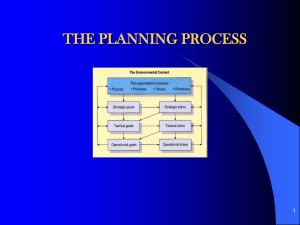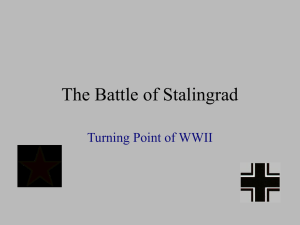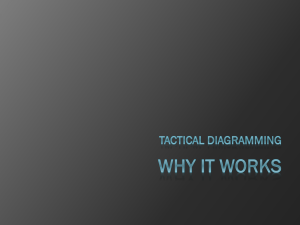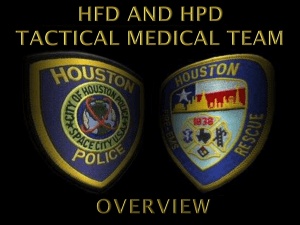Tactical & Strategic AI
advertisement
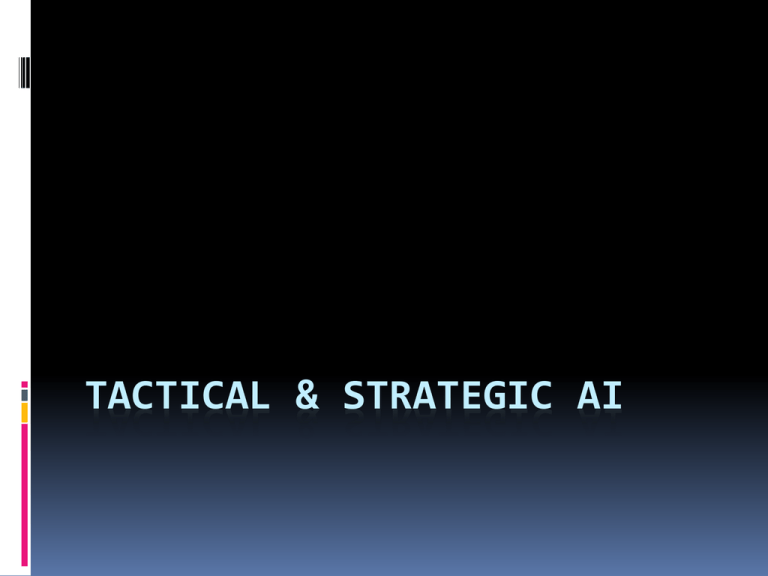
TACTICAL & STRATEGIC AI Tactical and Strategic Reasoning Covers… Deducing tactical situations from sketchy (limited) information Using tactical situations to make decisions Coordinating between multiple characters …and more…. Waypoint Tactics • A waypoint – a single position in the game level (“nodes”, “representative points” used for pathfinding) • To use waypoints tactically need to add more data to the nodes (not just location info) • Waypoints can be used to represent positions in the level with unusual tactical features (so that characters are better positioned tactically) • Normally the level designer has some say in this… Tactical Locations • Waypoints used for tactical purposes are sometimes called – “rally points” e.g. • To mark a fixed safe location for character to retreat if losing fight (defensive) • To mark a pre-determined hiding spot that can ambush or snipe incoming enemy (offensive) • To move secretly in shadow areas without being detected (stealth) • Many more… Tactical Locations Tactical Locations A game level consists of a large set of waypoints, each labeled with tactical qualities If waypoints used for pathfinding, they will also inherit other data such as connections etc. Practically, tactical locations are not very useful as part of a pathfinding graph… More efficient to have separate pathfinding graph and tactical location set Tactical Locations • Although common to combine two sets of waypoints (one for tactical, one for pathfinding), not efficient nor flexible • E.g. Cover and sniping waypoint nodes are not useful for pathfinding! Result in unrealistic movements within level Primitive and Compound Tactics • Most games have a set of pre-defined tactical qualities (e.g. sniping, shadow, cover, etc.). These are primitive defined tactics • Combination of these primitive tactics result in locations with compound tactical qualities. • E.g. Sniper locations – Points that have combination of both cover points and highvisibility points. • A point can have both defensive and offensive tactical features. Primitive and Compound Tactics For this e.g. how is an ambush point constructed from primitive tactical locations? More Compound Tactics – Waypoint Graphs • Waypoints can be CONNECTED to form waypoint graphs (similar to pathfinding graphs) when the waypoints defined are not isolated/separated • Where is the best spot for a hit-and-run move? • Topological analysis Continuous Tactics • Marking locations with numerical values (able to use fuzzy logic and probabilities) instead of Boolean values • E.g. A waypoint will have a value for cover feature (0.7) and visibility feature (0.9) • In choosing between a few cover points to go, choose one that has better/higher value • Using fuzzy logic rules can allow us to combine these values, E.g. • Sniper (value) = cover (value) AND visibility (value) • Sniper = MIN(0.7, 0.9) = 0.7 Using Tactical Locations • How do we build a tactical mechanism within the character AI? • Three approaches: 1. Controlling tactical movement (simple method) 2. Incorporate tactical information into decision- making 3. Use tactical information during pathfinding to produce character motion that is always tactically aware 1. Tactical Movement • Tactical waypoints are queried during game when the character AI needs to make a tactical move • E.g. Character needs to reload bullets, it queries the tactical waypoints in the immediate area to look for “nearest suitable location” to stop and reload, before continuing • Action decision is carried out first, then apply tactical information to achieve its decision • Limitation: Some realism, not able to use tactical information to influence decision making 2. Tactical Information in Decision-Making • Give the “decision-maker” access to tactical information, just like any other game world information • DT example: • SM: Trigger transitions only when certain waypoints are available and/or fulfill required numeric value (if used) 3. Tactical Information during Pathfinding • Relatively simple extension of basic pathfinding. • Rather than finding shortest/quickest path, it takes into consideration tactical situation of game • Simplest way is to manipulate graph connection costs (by adding “tactical cost” to locations that are dangerous or reducing “tactical cost” at locations that are easy) Finding nearby waypoints To use any of these approaches, a fast method is needed to generate nearby waypoints Given location of character, generate a list of suitable waypoints in order of distance Methods to work out what objects are nearby Binary space partitions (BSP), quad-trees, multiresolution maps Creating waypoints So far we assumed the waypoints are pre- created (by developer or level designer), and the properties have been decided This is the most common practice – 1) Actual properties are decided, 2) context-sensitive information placed at locations to be interpreted later It is also possible to CALCULATE the tactical properties of each location automatically – cover, visibility, shadow points, etc. Tactical Analyses • Sometimes known as influence maps – a technique pioneered and widely used in RTS games where the AI keeps track of areas of military influence in game • Can also be used in simulation/evolution games, FPSs or MMOs • Overwhelming majority of current implementations are based on tile-based grid worlds. Even for nontile-based worlds, a grid can be imposed over the geometry for tactical analyses. • Already discussed In Pathfinding lesson Revising Influence Maps Keeps track of “military” influence at each location level Calculations – Linear/non-linear drop-off Limited radius of effect – to constrain calculations to a finite circular area Allows game AI to analyze the game level, for strategic decision making “Fog-of-war” Combining Tactical Analyses • Multi-layer analyses involved combining a few influence maps into a composite influence map. • Example: To find best location to build tower, consider: Wide range of visibility, secured location, far from other towers to avoid redundancy (3 maps) • To get a single influence value, the 3 base tactical analyses can be combined by multiplication (or addition, etc.) Quality = Security x Visibility x Distance (or if tower influence is used instead of distance) Quality = Security x Visibility Tower Influence Combining Tactical Analyses Structure for Tactical Analyses Different types of tactical analyses can be distinguished by its properties and frequency of updating needed Tactical Pathfinding • Similar to regular pathfinding (same techniques/ algos), only modification is the cost function used – extended to tactical info • Cost function influenced by two criteria: 1. Distance/time 2. Tactical Information • Cost of a connection given by a formula C D wiTi i where D is the distance/time of connection, wi is the weighing factor for each tactic Ti and i is the number of tactics supported. Tactic Weights and Blending • The value for each tactic is multiplied by a weighting factor before summing into the final cost value. • Locations with high tactics weight will be avoided • Locations with low tactics weight will be favored • Weights can be negative, BUT careful not to have negative overall weight, which may result in negative overall cost! • Tactical costs can be pre-calculated if they are static (terrain, visibility). If they are dynamic (military power, number of units), they should be updated from time-to-time Customizing Weights • In certain games, different units can have different sets of tactical weights (w) based on their characteristic. • Example: Reconnaissance units, light infantry, heavy artillery. Tactical info: terrain difficulty, visibility, proximity of enemy units Customizing Weights • Weights can also be customized according to a unit’s aggression • E.g. Healthy units finds paths in normal way. When it is injured, the weight for proximity to enemy can be increased to make the unit choose a more conservative route back to base. Implications on heuristicbased pathfinding • When modifying pathfinding heuristics (especially for A*), make sure heuristic measure is not reduced too much due to subtraction of tactical costs, or increased too much due to addition of tactical costs. May result in underestimating or overestimating heuristic Coordinated Action • To coordinate multiple characters to cooperate together to get their job done, some structure need to be in place. Two categories: 1. Team/Group AI (a group of AI NPCs, fully AI) 2. Cooperative AI (AI cooperates with a human player in a team) • Common Qs: • Should individual AIs “speak” to each other, and make collective decisions? • Should a central “command center/brain” give orders and instructions to each individual AI? • Can we have a bit of both? Multi-Tier AI – Top-Down • Highest level AI makes a decision, passes it down to next level, which uses its instruction to make its decision, and pass again down to the lowest level • Example: Military Hierarchy Multi-Tier AI – Bottom-Up • Lowest level AI algorithms take their own initiative to make decisions, then use higher level algorithms to provide information on which they can base their actions • Example: Autonomous decision making by individual characters that can influence the overall game: Squad-based Strategy games, Evolution-based games • “Emergent cooperation” Multi-Tier AI – Example Multiple levels – Each character ha s its own AI, squads of characters together will have a different set of AI algorithms Multi-Tier AI – Example Player involvement in group AI: Recognition of player actions and passing down to next layers Intermediate layers between player and individual AIs should rely on player action Decision making can act to complement player Structuring Multi-Tier AI 2 infrastructure components: A communication mechanism to transfer orders from higher layers in the hierarchy downward: Overall strategy, assigned targets, areas of avoid, etc. A hierarchical scheduling system to execute the correct behaviors at the right time, in the right order, and only when required Emergent Cooperation Less centralized, more free-flowing Characters take into account what other characters are doing (e.g. moving together) Emergent Cooperation E.g. FSM for four characters in a team – provide mutual cover and working coherently If any member is removed, team operates as usual


